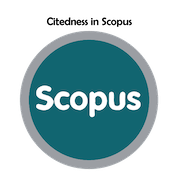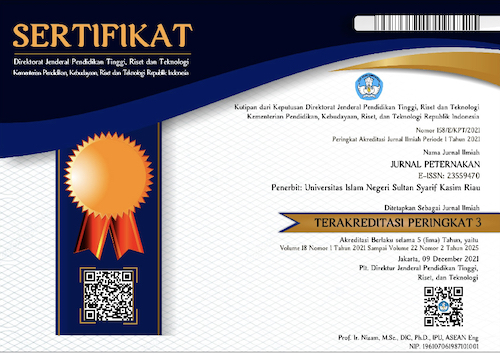Image of Infrared Thermography and Rectal Temperature of Ewes During Estrus Given Multinutrient Block Supplementation
Abstract
The aims of this study was to look at infrared thermography images and rectal temperature of ewes during estrus that were given multinutrient block supplementation. This study used 16 ewes that had given birth at least once, were in healthy condition, and had a normal reproductive cycle. The feed ingredients used are forage, MNB I (basic MNB), MNB II (MNB I added with Moringa leaves), and MNB III (MNB II plus the mineral Zn). The parameters observed were rectal temperature, microclimate temperature conditions, and infrared thermography images taken. The data from the analysis were tested for significance using ANOVA. Providing multinutrient block feed (MNB) supplementation to sheep based on vulva temperature parameters taken from a thermal camera showed a faster estrous response compared to sheep that were not given MNB. From the results of the three types of MNB, there was no significant difference in the duration of estrus symptoms. Infrared thermography can be used to strengthen the determination of the estrus phase in ewes.
Keywords
Full Text:
PDFReferences
Agboun, T., Apugo-Nwosu, T., Mohammed, J., Ameh, A., Abubakar, G., Mustapha, M., & Okoro, P. 2016. Potentials of Using Moringa oleifera Seeds in the Bioremediation of Soil Contaminated by Crude Oil. British Journal of Applied Science & Technology, 15(1), 1–8.https://doi.org/10.9734/BJAST/2016/9358.
Ahmad, W., Noor, MA, Afzal, I., Bakhtavar, MA, Nawaz, MM, Sun, application of natural growth-promoting substances under a changing climate. Sustainability, 8.
Alsaaod, M., Syring, C., Dietrich, J., Doherr, M., Gujan, T., & Steiner, A. 2014. A field trial Infrared thermography as a non-invasive diagnostic tool for early detection of digital dermatitis in cow's diary. The Veterinary Journal, 199, 281–285.https://doi.org/10.1016/j.tvjl.2013.11.028
Baptista, ATA, Silva, MO, Gomes, RG, Bergamasco, R., Vieira, MF, & Vieira, AMS 2017. Protein fractionation of seeds of Moringa oleifera lam and its application in superficial water treatment. Separation and Purification Technology, 180, 114–124.https://doi.org/10.1016/j.seppur.2017.02.040.
Deak, FLGB, Chacur, MGM, Souza, CD de, Andrade, IB, Cornacini, GF, Garcia, AR, & Filho, LRAG 2019. Effects of physiological stage and season on infrared thermograms of different body areas of dairy cows raised under tropical conditions. Animal Reproduction, 16(2), 311–316.https://doi.org/10.21451/1984-3143-AR2017-0023.
George, W., Godfrey, R., Ketring, R., Vinson, M., & Willard, S. 2014. Relationship between aye and muzzle temperatures measured using digital infrared thermal imaging and vaginal and rectal temperatures in hair sheep and cattle. Journal of Animal Science, 92(11), 4949–4955.https://doi.org/10.2527/jas.2014-8087.
Gopalakrishnan, L., Doriya, K., & Kumar, DS 2016. Moringa oleifera: A review on nutritive importance and its medicinal applications. Food Science and Human Wellness, 5(2), 49–56.https://doi.org/10.1016/j.fshw.2016.04.001.
Gupta, R., Mathur, M., Bajaj, VK, Katariya, P., Yadav, S., Kamal, R., & Gupta, RS 2012. Evaluation of antidiabetic and antioxidant activity of moringa oleifera in experimental diabetes. Journal of Diabetes, 4(2), 164–171.https://doi.org/10.1111/j.1753-0407.2011.00173.x.
Hoffman, G., Schmidt, M., Ammon, C., Rose-Meierhöfer, S., Burfeind, O., Heuwieser, W., & Berg, W. 2012. Monitoring the body temperature of cows and calves using video recordings from an infrared thermography camera. Veterinary Research Communications, 37(2), 91–99.https://doi.org/10.1007/s11259-012-9549-3.
Hovinen, M., Siivonen, J., Taponen, S., Hänninen, L., Pastell, M., Aisla, AM, & Pyörälä, S. 2008. Detection of clinical mastitis with the help of a thermal camera. Journal of Dairy Science, 91(12), 4592–4598.https://doi.org/10.3168/JDS.2008-1218.
Iskandar, AB, Pujaningsih, RI, & Widiyanto, W. 2020. The effect of multinutrient blocks (MNB) as complementary feed on albumin, globulin and A/G ratio levels in local goats. Indonesian Journal of Animal Science, 15(2), 132–137.https://doi.org/10.31186/jspi.id.15.2.132-137.
Kurnianto, E. 2010. Livestock Breeding. Graha Ilmu, Yogyakarta.
McManus, C., Tanure, C.B., Peripolli, V., Seixas, L., Fischer, V., Gabbi, A.M., Menegassi, SRO, Stumpf, M.T., Kolling, G.J., Dias, E., & Costa, J.B.G. 2016 Infrared thermography in animal production: An overview. Computers and Electronics in Agriculture, 123, 10–16.https://doi.org/10.1016/j.compag.2016.01.027.
Nardone, A., Ronchi, B., Lacetera, N., Ranieri, MS, & Bernabucci, U. 2010. Effects of climate changes on animal production and sustainability of livestock systems. Livestock Science, 130(1–3), 57–69.https://doi.org/10.1016/j.livsci.2010.02.011.
Pamungkas, FA, Purwanto, BP, Manalu, W., Yani, A., & Sianturi, RG 2020. The Application of Infrared Thermography in Monitoring Reproductive Physiology Status of Ruminants Due to Heat Stress. Indonesian Bulletin of Animal and Veterinary Sciences, 30(1), 25.https://doi.org/10.14334/wartazoa.v30i1.2243.
Perez Marquez, HJ, Ambrose, DJ, Schaefer, AL, Cook, NJ, & Bench, CJ 2019. Infrared thermography and behavioral biometrics associated with estrus indicators and ovulation in estrus-synchronized dairy cows housed in tiestalls. Journal of Dairy Science, 102(5), 4427–4440.https://doi.org/10.3168/JDS.2018-15221.
Piccione, G., Caola, G., & Refinetti, R. 2003. Circadian rhythms of body temperature and liver function in fed and food-deprived goats. Comparative Biochemistry and Physiology Part A: Molecular & Integrative Physiology, 134(3), 563–572.https://doi.org/10.1016/S1095-6433(02)00362-8.
Popalayah, Ismaya, & Ngadiyono, N. 2014. Effectiveness of using controlled internal drug release on estrus response and estrogen hormone concentrations in peanut and bligon goats. Livestock Bulletin, 37(3), 148.https://doi.org/10.21059/buletinpeternak.v37i3.3079.
Roberto, JVB, Souza, BB, Furtado, DA, Delfino, LJB, & Marques, BAA 2014. Gradientes térmicos e respostas fisiológicas de caprinos no semiárido brasileiro utilizando a thermografia infravermelha. Journal of Animal Behavior and Biometeorology, 2(1), 11–19.https://doi.org/10.14269/2318-1265.v02n01a03.
Santoso, K., Hendika, RY, Ulum, MF, . A., Arif, R., Suprayogi, A., & Seminar, KB 2023. Mapping horse body surface temperature patterns using an infrared camera. Journal of Veterinary Science, 41(1), 11.https://doi.org/10.22146/jsv.66859.
Sathiyabarathi, M., Jeyakumar, S., Manimaran, A., Jayaprakash, G., Pushpadass, HA, Sivaram, M., Ramesha, KP, Das, DN, Kataktalware, MA, Prakash, MA, & Kumar, RD 2016 Infrared thermography: A potential noninvasive tool to monitor udder health status in dairy cows. Veterinary World, 9(10), 1075–1081.https://doi.org/10.14202/vetworld.2016.1075-1081.
Sejian, V., Bhatta, R., Gaughan, JB, Dunshea, FR, & Lacetera, N. 2018. Review: Adaptation of animals to heat stress. Animal, 12, s431–s444. https://doi.org/10.1017/S1751731118001945
Sodiq, A. and Z. Abidin. 2002. Fattening sheep: Tips for overcoming practical problems. Agromedia Pustaka, Jakarta.
Suyanto, Malik, A., & Widaningsih. 2020. Additional feeding of urea molasses multinutrient moringa block (UM3B) on the onset and duration of estrus in beef cattle. Uniska Journal.http://eprints.uniska-bjm.ac.id/438/1/JURNAL%20%28SUYANTO%29%20pdf.pdf.
Sykes, DJ, Couvillion, J.S., Cromiak, A., Bowers, S., Schenck, E., Crenshaw, M., & Ryan, PL 2012. The Use of digital infrared thermal imaging to detect estrus in gilts. Theriogenology, 78(1), 147–152.https://doi.org/10.1016/j.theriogenology.2012.01.030.
Wulandari S, Fathul F, and Liman. 2015. Effect of various agricultural waste compositions on water, ash and crude fiber content in wafers. Integrated Animal Husbandry Scientific Journal. 3(3): 104-109.
DOI: http://dx.doi.org/10.24014/jupet.v20i2.24917
Refbacks
- There are currently no refbacks.
Jurnal Peternakan has been accredited by Sinta 3 : Number 158/E/KPT/2021
Starting from Vol. 18 No. 1 Year 2021 to Vol. 22 No. 2 Year 2025
Jurnal Peternakan Indexed By:
Editorial Office:
Jurnal Peternakan
Faculty of Agriculture and Animal Science, State Islamic University of Sultan Syarif Kasim Riau.
H.R. Soebrantas street KM. 15,5 Panam – Pekanbaru city.
E-mail: jurnal.peternakan@uin-suska.ac.id
ejournal: http://ejournal.uin-suska.ac.id/index.php/peternakan

Creation is distributed under the Creative Commons Attribution 4.0 International License. View Mystats














